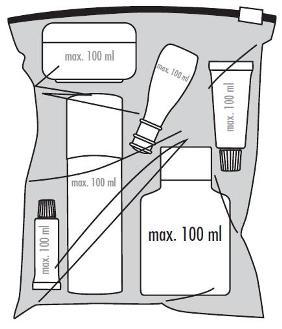Following the terrorist attempts to blow up several aircraft during flight using homemade explosives at London-Heathrow Airport in 2006, the European Commission adopted additional rules on aviation security to address this newly-identified threat.
New rules restrict passengers on carrying liquids, aerosols and gels (LAGs) past screening points, whether on their persons or in their hand luggage, with the following exemptions:
- liquids in individual containers with capacity no greater than 100 milliliters packed in one transparent one-liter re-sealable plastic bag;
- liquids which are to be used during the trip for medical purposes or special dietary requirements, including baby food;
- EU duty free liquids which have been obtained at EU airports or on board of an aircraft of an EU carrier on condition that they are packed in packed in security tamper-evident bag (STEB), inside which proof of purchase at airside at that airport on that day is displayed, as recommended by International Civil Aviation Organization;
- duty-free liquids purchased at certain airports in Croatia, Malaysia, Singapore or at international airports in Canada or the U.S on condition that they are packed in a STEB inside which satisfactory proof of purchase at airside at that airport within the preceding 36 hours is displayed.
This ban was envisaged as a temporary restriction to be lifted when suitable technology to screen liquids for explosives became readily available.
Following successful operational trials and in close cooperation with the international partners, the Commission developed a road map leading to a stepped approach for replacing the restriction on the carriage of LAGs with technological screening. On 19 March 2013 the Commission adopted the necessary legal changes to implement the first step of this phased approach. Phase 1 will enter into force on 31 January 2014 at the latest and will make it mandatory for airports to screen with special liquid explosive detection equipment at least LAGs in STEBs (security tamper evident bags) purchased at airports and any liquid medicine or special dietary needs. The operational impact of this first phase will be closely monitored and evaluated and if successful will lead to a further legislative amendment preparing the second phase. Any further legal obligations will be subject to agreement of Member State regulatory committee on aviation security and scrutiny by the European Parliament and Council.

